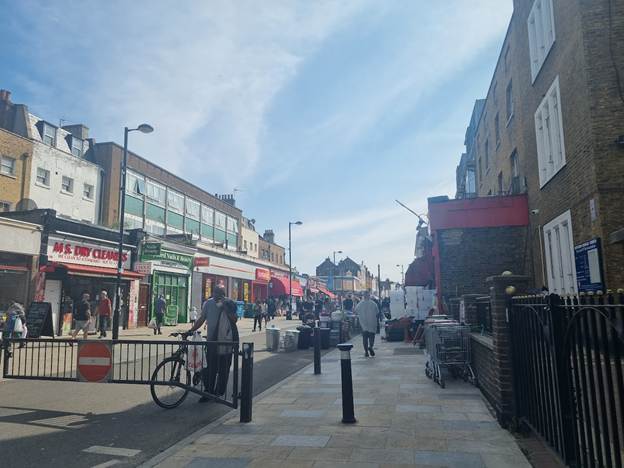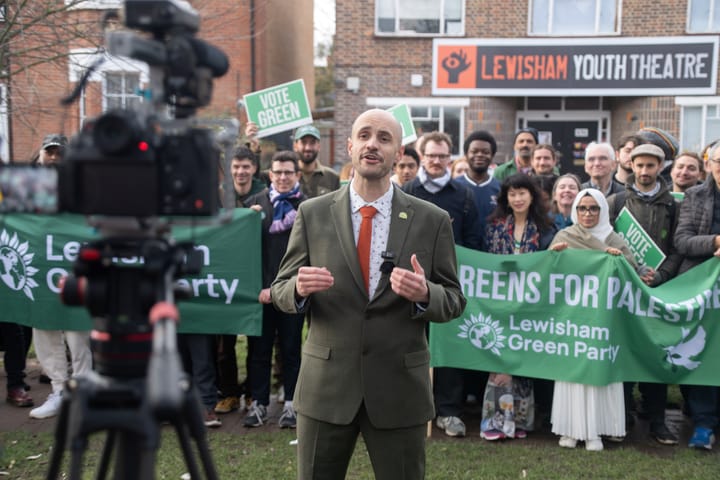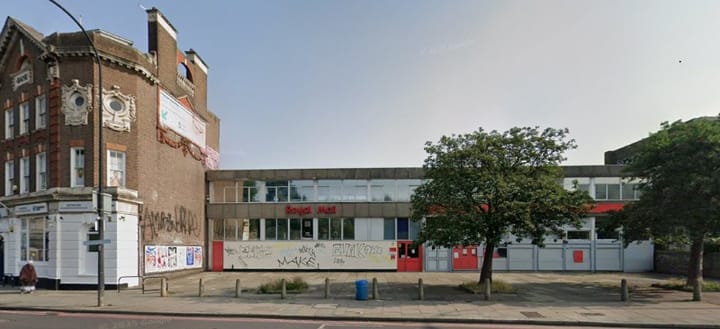Deptford High Street – hopes of pestrianisation crushed by gentrification fears
After years of consultation, the council has cancelled its proposal. The opposition campaign had a late surge, linking the plans to "accelerated gentrification".

It could have been transformative: showing that pedestrianised spaces belong not just to wealthy developments and corporate-owned spaces, but also in diverse neighbourhoods.
But the campaign opposing Lewisham council’s proposal to extend pedestrianisation of Deptford High Street harnessed claims about the proposed hours of operation, car ownership and most importantly fears of gentrification, to cancel the visionary scheme and offer up a bucket of paint instead.
The council announced: “Following the consultation held in April and May this year, we decided to prioritise further enhancing the high street and that no pedestrianisation scheme will come forward without further engagement.”
The initial proposal would have involved closing most of the high street to traffic from midmorning to early evening, seven days a week. Three different timing options were offered.
Although not always acknowledged by the opposition campaign, part of the high street is already closed to cars three days a week for the Deptford Market.
The campaign opposing the extension of pedestrianisation was launched during the last phase of the multi-year consultation and rapidly gained a high profile on social media and local media.
Fears of accelerated gentrification
According to the council’s report on the engagement: “The dominant concern was that proposed changes could accelerate gentrification, raising rents and displacing long-standing businesses, residents, and the working-class community.
"Many feared a loss of character and reduced accessibility for lower-income and disabled residents.”
Gentrification is a complex subject, but there is broad agreement that it centres on the costs and availability of housing, especially social and affordable housing. Rent controls would also put the brakes on gentrification.
Trust for London has found gentrification pushing up rents and house prices across different parts of the capital, alongside a drop in Black communities and fewer families. They found that one cause is estate regeneration projects – when the number of social housing households reduces, pressures on housing costs rise.
But if the benefits of an improvement to public space are open to all and may help reduce health inequality, they would not seem to be drivers of gentrification.
In Deptford High Street, reducing air pollution and improving road safety would have benefited diverse communities which are already suffering from environmental racism in health outcomes.
An improved public space with increased footfall could have benefited local businesses.

But in place of the council’s original vision for a full transformation of the street, pedestrianising from Ffinch Street to New Cross Road, improvements will be limited to repainting, lighting columns and removal of graffiti. With promised deep cleaning of pavements.
The engagement report notes: “While some welcomed urban greening, lighting, and cleaner streets, others criticised them as ‘greenwashing’—beautification efforts that fail to address deeper systemic issues like waste management, traffic displacement, and business support.”
The report adds: “Proposals were often viewed as benefiting newer, wealthier residents while disproportionately impacting disabled, elderly, and car-dependent residents.”
GLA research shows that households on low incomes are least likely to own a car. In Lewisham, only 52 of every 100 households own a car.
Pedestrianisation would have immediately reduced air pollution levels
The opposition campaign argued that air pollution is not an issue in Deptford High Street, but only a problem on the main roads nearby.
This claim was not based on monitoring and is not correct. Increasing the duration of pedestrianisation of the high street would have immediately reduced air pollution levels, benefitting everyone who uses it, and especially those who work or live there.
Research on air pollution continues to show its devastating health impacts across all age groups, including increases in chronic disease such as heart disease and dementia.
Lewisham borough had the first cause of death officially linked to air pollution, with the tragic case of nine year-old Ella Adoo-Kissi-Debrah who lived near the South Circular in Catford.
According to the Clean Cities Campaign, “the most deprived Londoners are over six times more likely to live in areas with higher levels of NO2 than the least deprived.”
Fears of gentrification were used as an argument against taking steps to improve the urban environment. But those across all incomes deserve clean air.
The opposition campaign also argued that removing cars from the high street would have created congestion on nearby roads. But research shows that pedestrianisation reduces trips by car and encourages "modal shift" to walking, scooting or cycling, instead of displacing traffic.
Walthamstow's mini-Holland
Areas such as Walthamstow have banned through traffic without losing their independent businesses.
Walthamstow has had a scheme for over a decade which shuts roads to through traffic yet retains a vibrant high street.
At the time of implementation, Walthamstow’s “mini-Holland” scheme faced ferocious opposition, but within a short period support had grown. A majority of respondents now say it has improved the area and it is supported by local businesses.
Researchers from Kings College have said that children living in the area would live longer due to the cleaner air.
Lewisham’s consultation found just 34% of respondents thought that pedestrianisation of the high street would make the street safer for pedestrians and cyclists. Surely a sign of the determination of 66% of respondents to oppose the scheme at all costs.
Worryingly, the council reports that: “Many distrusted the consultation framing, citing coercive survey designs and concerns that feedback would be ignored or misrepresented.”
The council’s timelines on larger improvements that don’t involve a can of paint or a broom, such as new cycle hangers or sustainable planters, will be announced in the future. For now though, it’s clear: the car is here to stay.
At least in Deptford.
Meanwhile, the London mayor has set up a Summer Streets fund and trialled al fresco dining in Brixton, Leyton, Shoreditch and recently Westminster. Businesses are backing the scheme.
All 32 boroughs have been invited to take part.
Sign-up for our free weekly newsletter - Salamander News in your inbox



